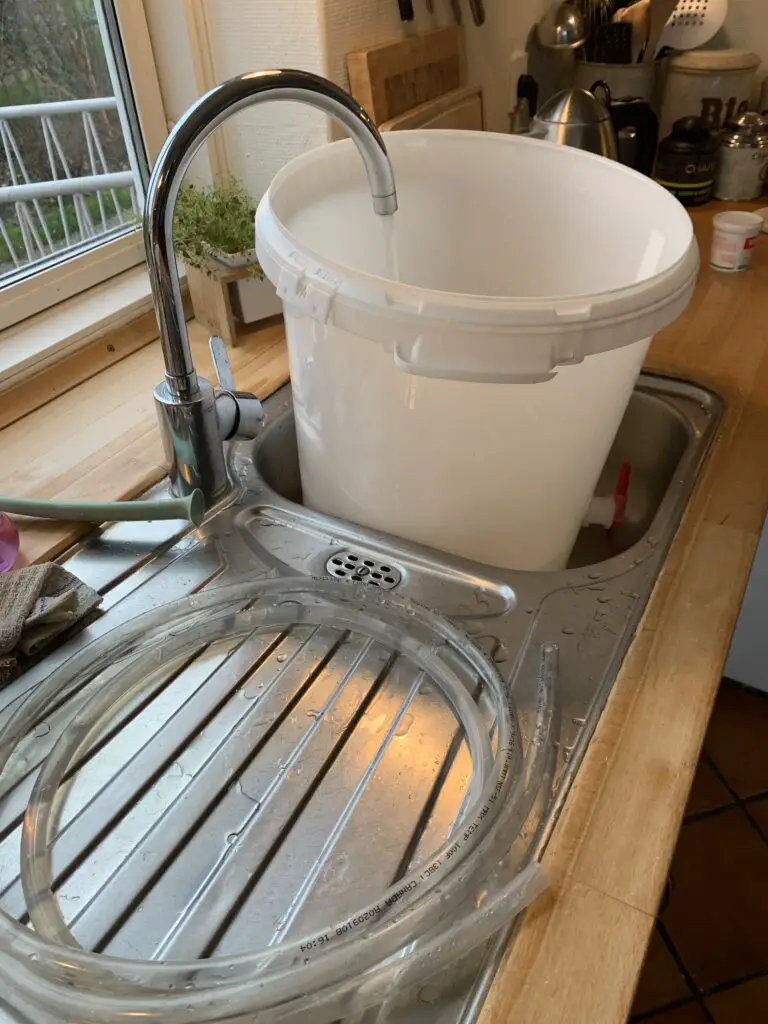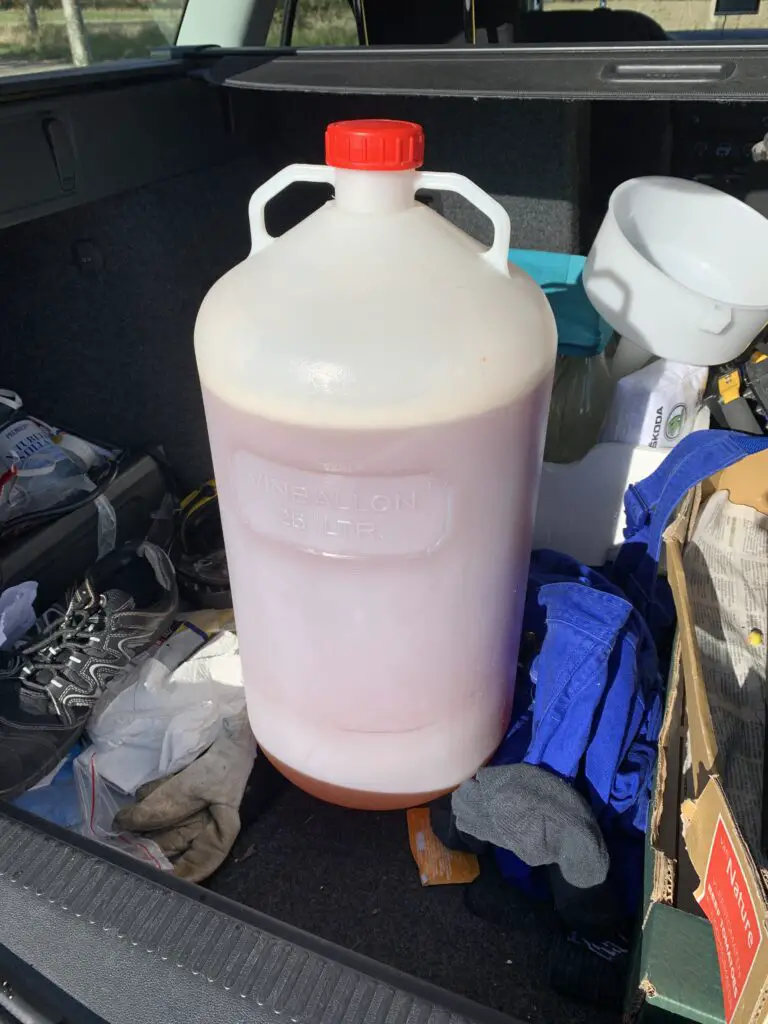The issue of glass carboys breaking
Glass carboys are a popular choice among homebrewers for fermenting their beer and wine. However, there have been instances where glass carboys have unexpectedly broken, causing damage, mess, and potential safety hazards.
I have now heard from several brewers that their glass carboy fermentation vessels suddenly break out of nowhere. There can be many reasons for this that we will address here, and we will get into how best to avoid this from happening!
This issue has raised concerns among brewers who favor glass over other materials like plastic or stainless steel. Understanding the causes of glass carboy breakage is crucial to prevent accidents and ensure a successful brewing experience.
Importance of understanding the causes
It is essential for brewers to recognize the causes of glass carboy breakages to minimize the risks involved.
By understanding what factors contribute to the breakage, brewers can take appropriate precautions to avoid potential accidents.
Moreover, identifying the causes helps brewers determine whether they should continue using glass carboys or switch to alternative options.
Stay tuned to learn about the common reasons behind glass carboy breakages and how you can prevent them.
II. Thermal Shock
Definition of thermal shock
Thermal shock refers to the rapid change in temperature that can cause materials, including glass, to expand or contract at different rates. This sudden change in temperature can create stress on the material, leading to cracks or breaks.

How it can cause glass carboys to break
Glass carboys are susceptible to thermal shock because of the nature of their use in home brewing. Here’s how thermal shock can cause glass carboys to break:
- Hot-to-cold transfer: When hot wort or liquid is transferred into a cold or room temperature glass carboy, the sudden change in temperature can cause the glass to expand and contract rapidly, leading to stress points.
- Cold-to-hot transfer: Similarly, transferring cold liquid into a preheated glass carboy can create thermal shock due to the sudden temperature change.
- Freezing and thawing: If a glass carboy is exposed to freezing temperatures, the expansion and contraction that occurs during the freezing and thawing process can weaken the glass and potentially lead to breaks.
Tips to avoid thermal shock
To avoid thermal shock and prevent glass carboys from breaking, consider the following tips:
- Gradual temperature change: Allow liquids to cool or heat gradually before transferring them into a glass carboy to minimize the risk of thermal shock.
- Use a temperature-stable environment: Ensure that your brewing area is maintained at a consistent temperature to avoid sudden changes when handling glass carboys.
- Preheat or precool the carboy: If you need to transfer hot or cold liquid, preheating or precooling the glass carboy before the transfer can help minimize the temperature difference.
- Avoid extreme temperature changes: Try to avoid exposing glass carboys to extreme temperature changes, such as placing them in direct sunlight on a hot day or leaving them outside in freezing temperatures.
By following these tips, you can reduce the risk of thermal shock and keep your glass carboys intact throughout the brewing process.

Please note that this information is based on common practices and recommendations. For more details and specific guidelines, it is advisable to consult with brewing experts or manufacturers of glass carboys.
III. Impact
How impact can lead to carboy fractures
Impact is one of the leading causes of glass carboy breakages. Even small impacts can create tiny fractures, hairline cracks, or stress points in the glass.

Over time, these weak spots can grow and eventually result in the bottom of the carboy falling out.
Glass has a memory, meaning that it retains the memory of each impact it has experienced. As more impacts occur, the glass becomes weakened, making it more susceptible to breakage.
Common scenarios where impact occurs
Some common scenarios where impact can occur with glass carboys include:
- Dropping or mishandling the carboy during transportation or during the brewing process.
- Bumping the carboy against hard surfaces, such as countertops or tables.
- Accidentally hitting the carboy with brewing equipment, such as airlocks or racking canes.
Proper handling techniques to prevent damage
To minimize the risk of impact-related breakages, it’s important to follow these proper handling techniques:
- Always handle the carboy with care, using both hands to provide support and stability.
- Avoid rough or sudden movements that can cause the carboy to collide with other objects.
- Use caution when moving the carboy, especially when transferring or cleaning it.
- Consider using a carboy handle or strap to provide additional grip and protection.
- Store your carboy in a safe and stable location where it won’t be easily bumped or knocked over.
By following these handling techniques, you can reduce the risk of impact-related fractures and ensure the longevity of your glass carboy. Remember, prevention is the key to avoiding breakages and enjoying a seamless brewing experience.
IV. Poor Annealing Creates Weak Glass
Explanation of annealing in glass manufacturing
Annealing is a critical process in glass manufacturing that involves heating and cooling the glass to relieve internal stresses and strengthen its structure. During the annealing process, the glass is heated to a specific temperature and then slowly cooled to ensure that it cools uniformly. This helps to prevent the glass from becoming brittle and susceptible to breaking.
The consequences of poor annealing in carboys
When glass carboys are not properly annealed during manufacturing, it can lead to weak spots and areas of stress within the glass. These weak spots make the carboys more prone to breaking when exposed to temperature changes or impacts.
Poor annealing can result in a higher risk of thermal shock and increased vulnerability to fractures, putting your precious brews at risk.
How to identify carboys with poor annealing
Identifying carboys with poor annealing can be challenging, as it is not always immediately apparent. However, there are a few indicators that can help you determine whether a carboy may have been poorly annealed:
- Look for any visible signs of stress marks or lines on the glass surface. These may appear as thin cracks or irregular patterns.
- Examine the bottom of the carboy closely for any irregularities or imperfections, as this is often a weak point in poorly annealed glass.
- Pay attention to the weight of the carboy. Poorly annealed glass carboys may feel lighter or thinner than properly annealed ones.
If you suspect that your carboy may have poor annealing, it is advisable to handle it with extra care and avoid subjecting it to sudden temperature changes or impacts. Consider investing in higher-quality glass carboys from reputable manufacturers that prioritize proper annealing processes.
Understanding the importance of annealing in glass manufacturing and being aware of the potential risks associated with poorly annealed carboys can help you make informed decisions when choosing brewing equipment, ensuring the safety of your brews and avoiding unnecessary breakages.
Learn more about the annealing process in glass manufacturing on Wikipedia.
V. Low-Quality Glass
The role of manufacturing quality in carboy durability
The quality of the glass used in manufacturing carboys plays a crucial role in their durability and resistance to breakage.
Low-quality glass, which may have manufacturing defects or inconsistencies, is more prone to failure and can compromise the integrity of the carboy. Here are some factors to consider:
Bubbles, inclusions, and inconsistent thickness as signs of low-quality glass: Low-quality glass may contain bubbles, inclusions, or uneven thickness, which weaken the structural integrity of the carboy. These imperfections can create stress points and increase the likelihood of breakage.
The importance of buying from reputable brands or suppliers
To minimize the risk of glass carboy breakage, it is important to buy from reputable brands or suppliers known for their commitment to quality. Consider the following tips:
Research and read reviews: Before purchasing a glass carboy, research different brands and read customer reviews to get an idea of their quality and durability.
Check for certifications: Look for carboys that have been tested and certified to meet safety standards, such as those set by the American Society for Testing and Materials (ASTM).
Invest in thicker glass: Thicker glass is generally more durable and less prone to breakage. Opting for carboys made from thicker glass can provide added strength and reduce the risk of failure.
Handle with care: Even with high-quality glass carboys, it is important to handle them with care to minimize the risk of breakage. Avoid dropping or banging the carboy against hard surfaces, and be cautious when moving or transporting it.
By investing in glass carboys from reputable brands or suppliers and being mindful of their handling, you can minimize the risk of breakage and enjoy the benefits of using glass for fermentation and brewing
VI. Consumer Advocacy
When it comes to the issue of glass carboys breaking, consumers play a vital role in demanding better quality and safety measures.

By voicing concerns and advocating for improved manufacturing standards, we can help prevent these accidents from happening in the future. Here are some actions consumers can take to promote change:
The power of consumers in demanding quality glass
- Research and choose reputable brands: Before purchasing a glass carboy, it’s important to do thorough research and choose brands known for their high-quality products. Look for reviews and feedback from other consumers to ensure you’re investing in a reliable and durable carboy.
- Report incidents and provide feedback: If you’ve experienced a glass carboy breaking or have concerns about the quality of a product, report the incident to the manufacturer and any relevant regulatory authorities. Providing feedback helps create awareness and can lead to improvements in manufacturing processes.
- Support standards and regulations: Stay informed about industry standards and regulations related to glass carboy manufacturing. Support initiatives that aim to establish and enforce these standards, as they can ensure consistent quality and safety of products.
Supporting retailers that prioritize quality
- Choose retailers that prioritize quality: When purchasing glass carboys, opt for retailers that have a reputation for selling high-quality products. Look for transparency in their sourcing and manufacturing practices to ensure you’re getting a reliable and safe product.
- Advocate for quality assurance: Engage with retailers and express your expectations for quality assurance measures. Encourage them to partner with manufacturers who prioritize rigorous testing and certification processes.
- Leave honest reviews: After purchasing a glass carboy, leave an honest review detailing your experience with the product. This helps other consumers make informed decisions and encourages manufacturers and retailers to consistently provide high-quality products.
By collectively advocating for better quality glass carboys, we can make a significant impact on improving their safety and durability. It’s important to remember that consumer feedback and demand play a crucial role in influencing manufacturing practices. Let’s work together to create a safer brewing experience for all.
VII. Alternatives to Glass Carboys
If you’re concerned about the risk of glass carboys breaking or simply prefer alternative options, there are a few alternatives to consider. Here are some factors to consider when choosing an alternative and the pros and cons of plastic and stainless steel options.

Factors to consider when choosing an alternative to glass
When looking for alternatives to glass carboys, there are several factors to consider to ensure you choose the best option for your brewing needs.
These factors include:
1. Durability: Look for a material that is durable and resistant to impact, ensuring your brewing vessel can withstand the rigors of brewing and transportation without the risk of breaking.
2. Safety: Consider the safety implications of the material you choose. Ensure that it is food-grade and does not leach any harmful chemicals into your brew.
3. Weight: Consider the weight of the alternative material, especially if you need to transport or move the vessel frequently.
4. Ease of cleaning: Look for an alternative that is easy to clean and sanitize, ensuring the quality of your brew is maintained.
Pros and cons of plastic and stainless steel options
Plastic carboys:
- Pros:
- Lightweight and easy to handle and transport.
- Much safer than glass as it will not shatter upon impact.
- Less expensive compared to glass or stainless steel options.
- Available in various sizes and shapes to suit your brewing needs.
- Cons:
- Not as durable as a stainless steel, with a higher risk of scratches and potential for bacterial buildup in scratches.
- May absorb odors over time.
Stainless steel fermenters:
- Pros:
- Highly durable and long-lasting.
- Resistant to scratches, rust, and other forms of damage.
- Easy to clean and sanitize.
- Does not absorb or leach any flavors into your brew.
- Can maintain temperature more effectively.
- Cons:
- Generally more expensive than plastic or glass options.
- Heavier and bulkier, making them less portable than plastic or glass.
Ultimately, the choice between plastic and stainless steel alternatives will depend on your brewing preferences, budget, and specific needs. Consider these factors carefully to make an informed decision.

Remember to always follow proper brewing practices and handle your brewing vessels with care, regardless of the material you choose.
To learn more about glass carboys and alternatives, you can visit this Wikipedia page.
VIII. Proper Maintenance and Inspection
Importance of regularly inspecting carboys for damage
Regular maintenance and inspection of glass carboys is crucial to ensure their longevity and prevent accidents. Here are the reasons why regularly inspecting carboys for damage is important:
- Safety: Inspecting carboys for any cracks, chips, or other damage ensures that they are safe to use. Damaged carboys can pose a risk of breaking during handling or fermentation, leading to potential injuries and damage to the surroundings.
- Preventing contamination: Cracks or chips in the glass can harbor bacteria or other contaminants, compromising the quality of your brew. Regular inspection helps identify and replace damaged carboys, ensuring a clean and safe brewing environment.
- Cost-effectiveness: Identifying damaged carboys early allows for timely replacements, reducing the risk of your entire batch of beer or wine being ruined. Regular inspections save you money in the long run by preventing unnecessary losses.
Tips for cleaning and storing glass carboys safely
Proper cleaning and storage practices are essential for maintaining the integrity of glass carboys. Here are some tips to follow:
- Cleaning:
- Rinse carboys immediately after use to remove any residue or sediment.
- Use a non-abrasive cleaner and a carboy brush to scrub the interior thoroughly.
- Rinse the carboy with clean water until all traces of the cleaner are removed.
- Allow the carboy to air dry upside down to prevent moisture buildup.
- Storage:
- Store carboys in a cool and dry place away from direct sunlight or extreme temperatures.
- Use carboy caps or stoppers to prevent dust or debris from entering the carboy.
- Avoid stacking multiple carboys, as the weight can increase the risk of damage.
- Consider using carboy storage crates or racks to provide additional stability and protection.
Regular maintenance, inspection, and proper cleaning and storage practices are vital for ensuring the longevity and safety of glass carboys. By following these tips, you can minimize the risk of breakage and enjoy a hassle-free brewing experience.
Remember to always handle glass carboys with care and avoid any sudden impacts or temperature shocks that may cause them to break.
Conclusion
In conclusion, the issue of glass carboys breaking is a concern for homebrewers seeking a reliable and safe fermentation vessel. Understanding the causes behind these breakages is essential to prevent accidents and ensure a successful brewing experience.
Thermal shock is a common cause of glass carboy breakage, arising from rapid temperature changes during liquid transfers or exposure to freezing temperatures. To prevent thermal shock, brewers should adopt gradual temperature changes, maintain a temperature-stable environment, and preheat or precool the carboy before transfers.
Impact is another leading cause of carboy fractures, often resulting from mishandling or accidents during transportation or brewing processes. Proper handling techniques, such as using both hands for support and using protective handles or straps, can significantly reduce the risk of impact-related breakages.
Poor annealing during the glass manufacturing process can create weak spots in carboys, making them more susceptible to temperature changes and impacts. Consumers can mitigate this risk by choosing reputable brands that prioritize quality assurance and proper annealing techniques.
The quality of the glass itself also plays a crucial role in carboy durability. Purchasing from reputable brands and leaving honest reviews can encourage manufacturers and retailers to prioritize high-quality materials, resulting in safer and more reliable products.
For those who prefer to avoid the risks associated with glass carboys altogether, alternatives like plastic and stainless steel options offer their own sets of pros and cons. Carefully considering factors such as durability, safety, weight, and ease of cleaning will help homebrewers make the best choice for their brewing needs.
Regular maintenance, inspection, and proper cleaning and storage practices are essential for ensuring the longevity and safety of glass carboys. Homebrewers should regularly check for any signs of damage, promptly replace compromised carboys, and follow proper cleaning and storage procedures to prevent contamination and extend the life of their brewing vessels.
As consumers, our advocacy and demand for quality products can drive positive change in the manufacturing process, leading to safer and more durable glass carboys. By voicing concerns, reporting incidents, and supporting reputable brands and suppliers, we can contribute to a safer brewing experience for all.
In the end, understanding the causes of glass carboy breakages empowers brewers to take the necessary precautions and make informed decisions about their brewing equipment. By prioritizing safety, quality, and proper handling practices, homebrewers can focus on their craft and enjoy the process without unnecessary worries about potential breakages. Happy brewing!




